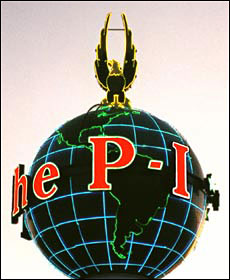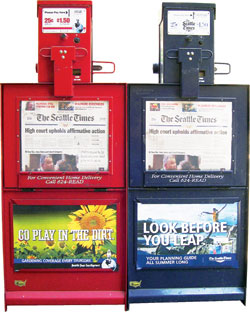It seemed that the Seattle Post-Intelligencer was just getting into a rhythm when The Seattle Times last week tripped the trapdoor in their joint operating agreement. Cartoonist Dave Horsey had just won his second Pulitzer Prize in three years. The P-I last year made a dramatic showing in the leading Northwest journalism competition, scoring 32 awards for excellence, compared to the Times‘ 19. It was the first time in decades the P-I had bested the Times in the contest sponsored by the Society of Professional Journalists.
By most accounts, it was the arrival of new publisher Roger Oglesby and managing editor David McCumber in 2000 that began to turn things around for the P-I, after years of distant but tight fiscal control by the Hearst Corp. Oglesby, who came from the Los Angeles Times, apparently brought with him corporate guarantees of material support for improving the P-I‘s content, staffing, and, perhaps most important, morale. During the Newspaper Guild strike later that year, Oglesby endeared himself to P-I staffers by settling with them before the Times reached agreement with its union workers, and then he hosted a gala welcome-back celebration. Times publisher Frank Blethen, on the other hand, seemed to take the strike personally and lashed out at staff members he felt had betrayed the Times “family.” For once, it felt really good to be working for Hearst.
All that goodwill and recent success under the P-I globe might be irrelevant now that the Times, which owns the printing presses, has given notice that it wants to negotiate closure of the P-I. By its own admission in a lawsuit last week, Hearst has taken substantial profit out of the P-I over the years under the JOA. How much better the P-I might have been if it had plowed more of that profit back into staffing and creative developmentwho knows? Hearst’s newspaper history is one of complacency. It does what little needs doing to keep the doors open and bleed the competition into either folding or selling, which is what Blethen fears would be the result of continuing the Seattle JOA.
There has always been a competitive spirit between the news staffs of the two papers, even under joint business operation. Hearst and the Seattle Times Co. forged their alliance 20 years ago under the Newspaper Preservation Act, the federal law with the noble purpose of preserving two editorial voices in cities where the weaker of two newspapers was threatened with financial collapse. The act exempted newspaper joint operating agreements from federal antitrust laws. But skeptics looked at such arrangements and saw not editorial voices as the main beneficiary, but publishers’ bottom lines. Two newspapers operating under an arrangement that allowed them to combine nonnews and noneditorial functions could dominate a metro market as never before, setting a single ad rate for both publications.
By 1981, the P-I had been losing money steadily for some 12 years. In Justice Department proceedings, Hearst argued that the P-I eventually would have to fold because the market could no longer sustain two newspapers. The actual financial distress of the P-I was hard to determine, even after the Justice Department required both companies to open their books. One thing was clear to Times executives: No matter what Hearst was telling the Justice Department about imminent failure of the P-I, the deep pockets of the corporation could underwrite red ink for an indefinite period, making an end to their business competition desirable, sooner than later. Many wondered why the Times didn’t simply continue to drive the P-I out of business. The Times had a weekday circulation of about 235,000 in 1980, about 50,000 more than the P-I. With Boeing booming and blue-collar reading habits strongly tied to the afternoon paper, there seemed to be nothing in the way of the Times simply running the P-I into the ground.
In fact, the Times had launched a morning edition in 1980 that it marketed only at news racks. And there were signs that it was making a small but worrisome dent in the P-I‘s newsstand sales, which constituted more than a third of the P-I‘s total circulation. Some of the Times’ most aggressive reporters (including this writer) were put on a beefed-up night staff, then headed by Mike Fancher, who today is the Times’ executive editor. He kept them charged up with the hint that it was the beginning of big, new thingspossibly a complete conversion by the Times to the morning market. Reporters at both newspapers found the competition invigorating, even fun at times. It was a departure from the usual “Fairview Fanny” blandness that had characterized the Times for years. Stories that the P-I had traditionally beat the Times on were now appearing first in the Times morning edition.
Then it was over. The 1981 announcement that Hearst and the Times had reached terms on a joint operating agreement shocked both newsrooms. For the P-I, it would mean no more Sunday edition and, without it, permanent second-class status. For the Times, it was the end of its incursion into the morning and, so it seemed at the time, it would be stuck in an afternoon market showing signs of erosion. As the JOA commenced in 1983, after more than 18 months of hearings and appeals, the news competition between the two papers took on a sort of artificial quality in the minds of some. But animosity was an easily accessible emotion on both sides.
Little seemed to change at the P-I in the new world of the JOA. Hearst was still tightfisted with the money needed to improve staffing levels to “compete” with the Times, which was hiring new, talented young writers, redesigning the newspaper, and lavishing more resources on its photography department. While Hearst seemed content to float with the status quo at the P-I, the Times made some stunning gains in quality of content. Between 1981, when the two companies began JOA talks, and 1999, when the agreement was renegotiated, the Times won five Pulitzer Prizes. Management of the P-I seemed paralyzed at times, mercurial at others. Then-publisher J.D. Alexander’s insistence upon making the P-I a marginally skeptical booster of the new Mariners baseball stadium was embarrassing to many on the staff. Meanwhile, Blethen had reiterated to his news managers the need for continued, critical reporting on the stadium, despite the Times’ editorial endorsement of it.
The departure of P-I investigative ace Duff Wilson to the Times was a major blow to the morning daily’s investigative journalism efforts. Wilson later confessed to a colleague that just a few dollars more a week, offered in a less-grudging manner, would probably have kept him at the P-I. But the Times offered considerably more than Wilson could have turned down. While the P-I was finally showing a profit, thanks to the JOA, Hearst was providing only marginally more money to improve news content. Under Alexander, whose management style ranged from manipulative to moody, staff morale continued to slide. In spite of that, P-I staff members continued to do excellent work. Then came 1999, when Hearst agreed to let the Times switch to the morning market in exchange for relief from certain fees and, most notably, an increase in the P-I cut of JOA revenuefrom 34 percent to 40 percent.
In January 2000, shortly after the new JOA was implemented, with the Times sharing the morning slot with the P-I, Oglesby was named to replace Alexander as editor and publisher. Before the year was out, the Newspaper Guild strike was onincluding all news and editorial employees at both papers and ad salespeople and some circulation workers at the Times.
Partly due to the strike and continuing weakness in the economy, the P-I has been slow to respond to the marketing challenge posed by the Times’ move to morning. The circulation disparity between the two papers has since grownthe Times is now around 239,000 daily, with the P-I at about 155,000. Hearst complained in the lawsuit it filed last week that the Times sabotaged P-I circulation in a number of ways. Blethen counters that P-I circulation problems are not the result of any Times failure to sell the paper, but of the failure of P-I content to sell the paper.
The P-I content issue might be more related to readership targeting. The Times has spent considerable sums to seize control of the suburban market, which is where Blethen sees the best prospects for the paper’s future growth. Times suburban bureaus are now staffed by more than 50 reporters, editors, photographers, and graphic artists. The P-I has four reporters covering the burbs. The P-I can’t compete in the suburban ring. And it can’t compete in terms of sheer volume of news. If it is true, as Blethen has claimed, that where the two newspapers are offered side by side, the Times is outselling the P-I, the P-I needs to give readers a clear reason to choose it. Urban readers have shown an affinity for the P-I and its sometimes-feisty content. It seems that the P-I‘s best chance is to go after younger, urban professionals in the city itself. And, it is rumored, that is what the P-I is planning to do.
It had better hurry up. An 18-month clock is ticking now that the Times has said it wants to close the P-I. If the courts don’t come to the P-I‘s rescue and the Justice Department finds no grounds to intervene, the P-I likely will be forced to close by November 2004. For Hearst, that outcome isn’t exactly disastrous. It would then collect 32 percent of Times net revenue for the next eight decades.
If that’s what happens, it will be interesting to see if Hearst looks out for its loyal employees, who stood by the P-I in the toughest of times. Whatever passion one has seen in the P-I‘s journalism has been supplied by people who have had to pump themselves up to go out and compete against superior numbers, who do their best out of pride, without a hell of a lot of support from Hearst. They deserve guaranteed employment at the Times or a generous buyout, should the P-I fold. Perhaps the Hearst heirs, who are such silent shareholders, will make a strong suggestion to that effect to the calculating mandarins who run their affairs. We’ll see.
Former reporter and editor Dick Clever worked for the Seattle Post-Intelligencer from 1970-75 and again from 1988-96. He worked for The Seattle Times from 1980-87 and covered the original JOA process in the early 1980s.








